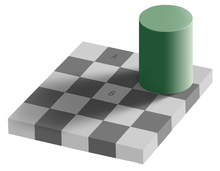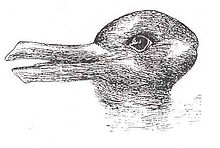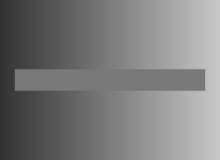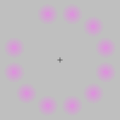- Optical illusion
-
This article is about visual perception. For the Time Requiem album, see Optical Illusion (album).An optical illusion. The square A is exactly the same shade of gray as square B. See checker shadow illusion.

An optical illusion (also called a visual illusion) is characterized by visually perceived images that differ from objective reality. The information gathered by the eye is processed in the brain to give a perception that does not tally with a physical measurement of the stimulus source. There are three main types: literal optical illusions that create images that are different from the objects that make them, physiological ones that are the effects on the eyes and brain of excessive stimulation of a specific type (brightness, colour, size, position, tilt, movement), and cognitive illusions, the result of unconscious inferences.
Contents
Physiological illusions
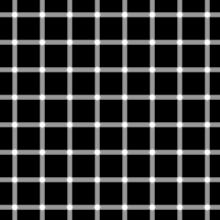 A scintillating grid illusion. Shape, position, colour, and 3D contrast converge to produce the illusion of black dots at the intersections.
A scintillating grid illusion. Shape, position, colour, and 3D contrast converge to produce the illusion of black dots at the intersections.
Physiological illusions, such as the afterimages following bright lights, or adapting stimuli of excessively longer alternating patterns (contingent perceptual aftereffect), are presumed to be the effects on the eyes or brain of excessive stimulation or interaction with contextual or competing stimuli of a specific type—brightness, colour, position, tile, size, movement, etc. The theory is that a stimulus follows its individual dedicated neural path in the early stages of visual processing, and that intense or repetitive activity in that or interaction with active adjoining channels cause a physiological imbalance that alters perception.
The Hermann grid illusion and Mach bands are two illusions that are best explained using a biological approach. Lateral inhibition, where in the receptive field of the retina light and dark receptors compete with one another to become active, has been used to explain why we see bands of increased brightness at the edge of a colour difference when viewing Mach bands. Once a receptor is active it inhibits adjacent receptors. This inhibition creates contrast, highlighting edges. In the Hermann grid illusion the gray spots appear at the intersection because of the inhibitory response which occurs as a result of the increased dark surround.[1] Lateral inhibition has also been used to explain the Hermann grid illusion, but this has been disproved.[citation needed] More recent "empirical" approaches to optical illusions have had some success in explaining optical phenomena with which theories based on lateral inhibition have struggled (e.g. Howe et al. 2005[2]).
Cognitive illusions
Cognitive illusions are assumed to arise by interaction with assumptions about the world, leading to "unconscious inferences", an idea first suggested in the 19th century by Hermann Helmholtz. Cognitive illusions are commonly divided into ambiguous illusions, distorting illusions, paradox illusions, or fiction illusions.
- Ambiguous illusions are pictures or objects that elicit a perceptual 'switch' between the alternative interpretations. The Necker cube is a well known example; another instance is the Rubin vase.
- Distorting or geometrical-optical illusions are characterized by distortions of size, length, position or curvature. A striking example is the Café wall illusion. Other examples is the famous Müller-Lyer illusion and Ponzo illusion.
- Paradox illusions are generated by objects that are paradoxical or impossible, such as the Penrose triangle or impossible staircases seen, for example, in M. C. Escher's Ascending and Descending and Waterfall. The triangle is an illusion dependent on a cognitive misunderstanding that adjacent edges must join.
- Fictions are when a figure is perceived even though it is not in the stimulus.
Explanation of cognitive illusions
Perceptual organization
To make sense of the world it is necessary to organize incoming sensations into information which is meaningful. Gestalt psychologists believe one way this is done is by perceiving individual sensory stimuli as a meaningful whole.[3] Gestalt organization can be used to explain many illusions including the Duck-Rabbit illusion where the image as a whole switches back and forth from being a duck then being a rabbit and why in the figure-ground illusion the figure and ground are reversible.
In addition, Gestalt theory can be used to explain the illusory contours in the Kanizsa Triangle. A floating white triangle, which does not exist, is seen. The brain has a need to see familiar simple objects and has a tendency to create a "whole" image from individual elements.[3] Gestalt means "form" or "shape" in German. However, another explanation of the Kanizsa Triangle is based in evolutionary psychology and the fact that in order to survive it was important to see form and edges. The use of perceptual organization to create meaning out of stimuli is the principle behind other well-known illusions including impossible objects. Our brain makes sense of shapes and symbols putting them together like a jigsaw puzzle, formulating that which isn't there to that which is believable.
Depth and motion perception
Illusions can be based on an individual's ability to see in three dimensions even though the image hitting the retina is only two dimensional. The Ponzo illusion is an example of an illusion which uses monocular cues of depth perception to fool the eye.
In the Ponzo illusion the converging parallel lines tell the brain that the image higher in the visual field is farther away therefore the brain perceives the image to be larger, although the two images hitting the retina are the same size. The Optical illusion seen in a diorama/false perspective also exploits assumptions based on monocular cues of depth perception. The M. C. Escher painting Waterfall exploits rules of depth and proximity and our understanding of the physical world to create an illusion.
Like depth perception, motion perception is responsible for a number of sensory illusions. Film animation is based on the illusion that the brain perceives a series of slightly varied images produced in rapid succession as a moving picture. Likewise, when we are moving, as we would be while riding in a vehicle, stable surrounding objects may appear to move. We may also perceive a large object, like an airplane, to move more slowly than smaller objects, like a car, although the larger object is actually moving faster. The Phi phenomenon is yet another example of how the brain perceives motion, which is most often created by blinking lights in close succession.
Colour and brightness constancies
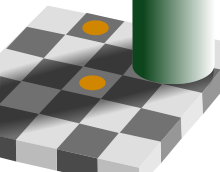 In this illusion, the coloured regions appear rather different, roughly orange and brown. In fact they are the same colour, and in identical immediate surrounds, but the brain changes its assumption about colour due to the global interpretation of the surrounding image. Also, the white tiles that are shadowed are the same colour as the grey tiles outside the shadow.
In this illusion, the coloured regions appear rather different, roughly orange and brown. In fact they are the same colour, and in identical immediate surrounds, but the brain changes its assumption about colour due to the global interpretation of the surrounding image. Also, the white tiles that are shadowed are the same colour as the grey tiles outside the shadow.
Perceptual constancies are sources of illusions. Colour constancy and brightness constancy are responsible for the fact that a familiar object will appear the same colour regardless of the amount of or colour of light reflecting from it. An illusion of colour or contrast difference can be created when the luminosity or colour of the area surrounding an unfamiliar object is changed. The contrast of the object will appear darker against a black field that reflects less light compared to a white field even though the object itself did not change in colour. Similarly, the eye will compensate for colour contrast depending on the colour cast of the surrounding area.
Object consistencies
Just as it perceives colour and brightness constancies, the brain has the ability to understand familiar objects as having a consistent shape or size. For example a door is perceived as rectangle regardless of how the image may change on the retina as the door is opened and closed. Unfamiliar objects, however, do not always follow the rules of shape constancy and may change when the perspective is changed. The Shepard illusion of the changing table[4] is an example of an illusion based on distortions in shape constancy.
Future perception
Researcher Mark Changizi of Rensselaer Polytechnic Institute in New York has a more imaginative take on optical illusions, saying that they are due to a neural lag which most humans experience while awake. When light hits the retina, about one-tenth of a second goes by before the brain translates the signal into a visual perception of the world. Scientists have known of the lag, yet they have debated how humans compensate, with some proposing that our motor system somehow modifies our movements to offset the delay.
Changizi asserts that the human visual system has evolved to compensate for neural delays by generating images of what will occur one-tenth of a second into the future. This foresight enables humans to react to events in the present, enabling humans to perform reflexive acts like catching a fly ball and to maneuver smoothly through a crowd.[5] Illusions occur when our brains attempt to perceive the future, and those perceptions don't match reality. For example, an illusion called the Hering illusion looks like bicycle spokes around a central point, with vertical lines on either side of this central, so-called vanishing point. The illusion tricks us into thinking we are moving forward, and thus, switches on our future-seeing abilities. Since we aren't actually moving and the figure is static, we misperceive the straight lines as curved ones.
Changizi said:
"Evolution has seen to it that geometric drawings like this elicit in us premonitions of the near future. The converging lines toward a vanishing point (the spokes) are cues that trick our brains into thinking we are moving forward—as we would in the real world, where the door frame (a pair of vertical lines) seems to bow out as we move through it—and we try to perceive what that world will look like in the next instant."[5]
Illusions
Main article: List of optical illusionsArtists
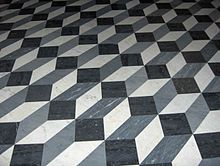 Floor tiles at the Basilica of St. John Lateran in Rome. The pattern creates an illusion of three-dimensional boxes.
Floor tiles at the Basilica of St. John Lateran in Rome. The pattern creates an illusion of three-dimensional boxes.
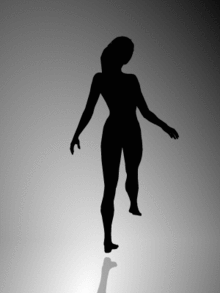 The Spinning Dancer appears to move both clockwise and counter-clockwise
The Spinning Dancer appears to move both clockwise and counter-clockwise
Artists who have worked with optical illusions include M. C. Escher, Bridget Riley, Salvador Dalí, Giuseppe Arcimboldo, Marcel Duchamp, Oscar Reutersvärd, Victor Vasarely and Charles Allan Gilbert. Contemporary artists who have experimented with illusions include Octavio Ocampo, Dick Termes, Shigeo Fukuda, Patrick Hughes, István Orosz, Rob Gonsalves, Gianni A. Sarcone, Ben Heine and Akiyoshi Kitaoka. Optical illusion is also used in film by the technique of forced perspective.
Cognitive processes hypothesis
The hypothesis claims that visual illusions occur because the neural circuitry in our visual system evolves, by neural learning, to a system that makes very efficient interpretations of usual 3D scenes based in the emergence of simplified models in our brain that speed up the interpretation process but give rise to optical illusions in unusual situations. In this sense, the cognitive processes hypothesis can be considered a framework for an understanding of optical illusions as the signature of the empirical statistical way vision has evolved to solve the inverse problem.[6]
Research indicates that 3D vision capabilities emerge and are learned jointly with the planning of movements. After a long process of learning, an internal representation of the world emerges that is well adjusted to the perceived data coming from closer objects. The representation of distant objects near the horizon is less "adequate". In fact, it is not only the Moon that seems larger when we perceive it near the horizon. In a photo of a distant scene, all distant objects are perceived as smaller than when we observe them directly using our vision.
The retinal image is the main source driving vision but what we see is a "virtual" 3D representation of the scene in front of us. We don't see a physical image of the world; we see objects, and the physical world is not itself separated into objects. We see it according to the way our brain organizes it. The names, colours, usual shapes and other information about the things we see pop up instantaneously from our neural circuitry and influence the representation of the scene. We "see" the most relevant information about the elements of the best 3D image that our neural networks can produce. The illusions arise when the "judgments" implied in the unconscious analysis of the scene are in conflict with reasoned considerations about it.
Gallery
-
Stare at the centre
See also
- Alice in Wonderland syndrome
- Auditory illusion
- Barberpole illusion (Barber's pole)
- Camouflage
- Contingent perceptual aftereffect
- Contour rivalry
- Depth perception
- Emmert's law
- Entoptic phenomenon
- Forced perspective
- Geometrical-optical illusions
- Gestalt psychology
- Gravity hill
- Hybrid image
- Infinity edge pool
- Kinetic depth effect
- Mirage
- Multistable Perception
- Op Art
- Trompe l'oeil
- Visual space
- Closed-eye hallucination / Closed-eye visualization
- Image burn-in / Afterimage / ghost image
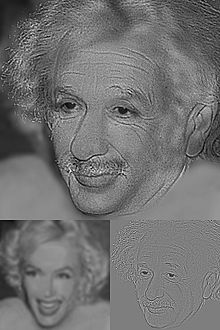 A hybrid image constructed from low-frequency components of a photograph of Marilyn Monroe (left inset) and high-frequency components of a photograph of Albert Einstein (right inset). The Einstein image is clearer in the full image.
A hybrid image constructed from low-frequency components of a photograph of Marilyn Monroe (left inset) and high-frequency components of a photograph of Albert Einstein (right inset). The Einstein image is clearer in the full image.
Notes
- ^ Pinel, J. (2005) Biopsychology (6th ed.). Boston: Allyn & Bacon. ISBN 0-205-42651-4
- ^ Howe, Catherine Q., Yang, Zhiyong, & Purves, Dale (2005). The Poggendorff illusion explained by natural scene geometry. PNAS 102(21): 7707-7712.
- ^ a b Myers, D. (2003). Psychology in Modules, (7th ed.) New York: Worth. ISBN 0-7167-5850-4
- ^ Bach, Michael (16 August 2004 (last update 2010-01-04)). "Shepard’s “Turning the Tables”". http://www.michaelbach.de/ot/index.html 86 Optical Illusions & Visual Phenomena. Michael Bach. Archived from the original on 27 January 2010. http://www.webcitation.org/5n6VqCltF. Retrieved 27 January 2010.
- ^ a b Key to All Optical Illusions Discovered, Jeanna Bryner, Senior Writer, LiveScience.com 6/2/08. His research on this topic is detailed in the May/June 2008 issue of the journal Cognitive Science.
- ^ Knowledge in perception and illusion by Richard L. Gregory
References
- Changizi, Mark A. et al. (2008): Perceiving the Present and a Systematization of Illusions. Cognitive Science 32,3 : 459-503.
- Eagleman, D.M. (2001) Visual Illusions and Neurobiology. Nature Reviews Neuroscience. 2(12): 920-6. (pdf)
- Gregory Richard (1997) Knowledge in perception and illusion. Phil. Trans. R. Soc. Lond. B 352:1121-1128. (pdf)
- Purves D, Lotto B (2002) Why We See What We Do: An Empirical Theory of Vision. Sunderland, MA: Sinauer Associates.
- Purves D, Lotto RB, Nundy S (2002) Why We See What We Do. American Scientist 90 (3): 236-242.
- Purves D, Williams MS, Nundy S, Lotto RB (2004) Perceiving the intensity of light. Psychological Rev. Vol. 111: 142-158.
- Renier, L., Laloyaux, C., Collignon, O., Tranduy, D., Vanlierde, A., Bruyer, R., De Volder, A.G. (2005). The Ponzo illusion using auditory substitution of vision in sighted and early blind subjects. Perception, 34, 857–867.
- Renier, L., Bruyer, R., & De Volder, A. G. (2006). Vertical-horizontal illusion present for sighted but not early blind humans using auditory substitution of vision. Perception & Psychophysics, 68, 535–542.
- Yang Z, Purves D (2003) A statistical explanation of visual space. Nature Neurosci 6: 632-640.
External links
- Optical illusions and perception paradoxes by Archimedes Lab
- Project LITE Atlas of Visual Phenomena
- Akiyoshi's illusion pages Professor Akiyoshi KITAOKA's anomalous motion illusions
- Spiral Or Not? by Enrique Zeleny, Wolfram Demonstrations Project
- Hunch Optical Illusions by Hunch
- Silencing awareness of visual change by motion by Harvard vision lab
- Upload an image to convert it to an AfterImage. Disclaimer:Viewing such images repeatedly may not be a healthy habit for the eyes by Murtaza Gandhi
Categories:- Optical illusions
- Optical phenomena
- Consciousness studies
Wikimedia Foundation. 2010.

